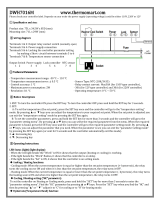
xi
Be sure to observe the following precautions to prevent operation failure, malfunction, or adverse affects on
the performance and functions of the product. Not doing so may occasionally result in unexpected events.
1) The product is designed for indoor use only. Do not use the product outdoors or in any of the following
locations.
• Places directly subject to heat radiated from heating equipment.
• Places subject to splashing liquid or oil atmosphere.
• Places subject to direct sunlight.
• Places subject to dust or corrosive gas (in particular, sulfide gas and ammonia gas).
• Places subject to intense temperature change.
• Places subject to icing and condensation.
• Places subject to vibration and large shocks.
2) Use and store the Digital Temperature Controller within the rated ambient temperature and humidity.
Gang-mounting two or more temperature controllers, or mounting temperature controllers above each
other may cause heat to build up inside the temperature controllers, which will shorten their service life. In
such a case, use forced cooling by fans or other means of air ventilation to cool down the Digital
Temperature Controllers.
3) To allow heat to escape, do not block the area around the product. Do not block the ventilation holes on
the product.
4) Be sure to wire properly with correct polarity of terminals.
5) Use the specified size (M3.5, width 7.2 mm or less) crimped terminals for wiring. For open-wired
connection, use stranded or solid copper wires with a gage of AWG24 to AWG14 (equal to a cross-
sectional area of 0.205 to 2.081 mm
2
). (The stripping length is 5 to 6 mm.) Up to two wires or two crimp
terminals can be inserted into a single terminal.
6) Do not wire the terminals which are not used.
7) To avoid inductive noise, keep the wiring for the Digital Temperature Controller's terminal block away from
power cables carry high voltages or large currents. Also, do not wire power lines together with or parallel
to Digital Temperature Controller wiring. Using shielded cables and using separate conduits or ducts is
recommended.
Attach a surge suppressor or noise filter to peripheral devices that generate noise (in particular, motors,
transformers, solenoids, magnetic coils or other equipment that have an inductance component).
When a noise filter is used at the power supply, first check the voltage or current, and attach the noise
filter as close as possible to the temperature controller.
Allow as much space as possible between the Digital Temperature Controller and devices that generate
powerful high frequencies (high-frequency welders, high-frequency sewing machines, etc.) or surge.
8) Use this product within the rated load and power supply.
9) Make sure that the rated voltage is attained within two seconds of turning ON the power using a switch or
relay contact. If the voltage is applied gradually, the power may not be reset or output malfunctions may
occur.
10) Make sure that the Temperature Controller has 30 minutes or more to warm up after turning ON the power
before starting actual control operations to ensure the correct temperature display.
11) When executing self-tuning, turn ON power for the load (e.g., heater) at the same time as or before
supplying power to the Digital Temperature Controller. If power is turned ON for the Digital Temperature
Controller before turning ON power for the load, self-tuning will not be performed properly and optimum
control will not be achieved.
12) A switch or circuit breaker should be provided close to this unit. The switch or circuit breaker should be
within easy reach of the operator, and must be marked as a disconnecting means for this unit.
13) Always turn OFF the power supply before pulling out the interior of the product, and never touch nor apply
shock to the terminals or electronic components. When inserting the interior of the product, do not allow
the electronic components to touch the case.
Precautions for Safe Use






















